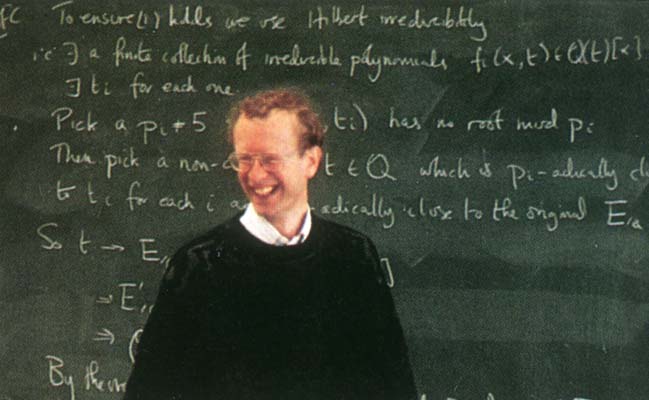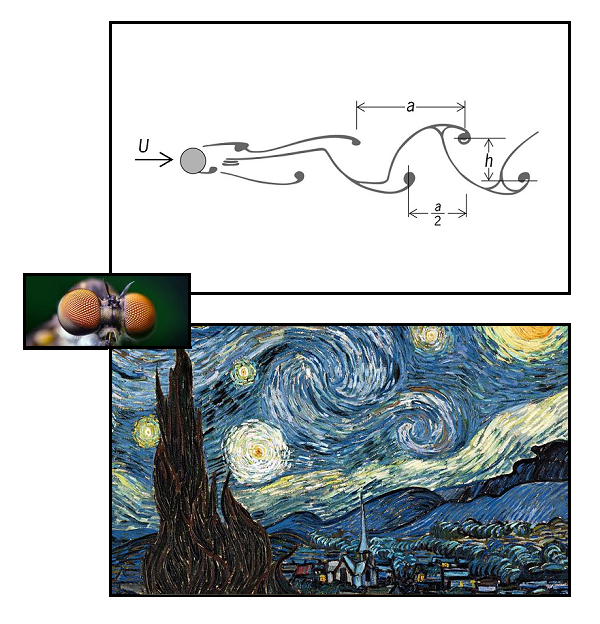In this piece — written in 2003 or perhaps earlier — I offer an exploration of Andrew Wiles’ proof as described in the book, Fermat’s Last Theorem by Simon Singh, in the light of the Glass Bead Game posited by Hermann Hesse in his Nobel-winning novel Das Glasperlenspiel, together with my own suggestion that the richest “move” in such a game would consist of a rich isomorphism between rich chunks of knowledge in widely separated disciplines… — essentially, that’s a Sembl move.
…..
 Andrew Wiles
Andrew Wiles
…..
The mathematician Pierre de Fermat scribbled a note in the margin of his copy of Diophantus‘ Arithmetica in 1637 or thereabouts claiming that there were no solutions to the equation
x^n + y^n = z^n
where n is greater than 2, along with a note saying “I have a marvellous demonstration of this proposition which this margin is too narrow to contain”.
Mathematicians as great as Leonhard Euler strove to prove or disprove the theorem without success for three and a half centuries:
Consider the leaps in understanding in physics, chemistry, biology, medicine and engineering that have occurred since the seventeenth century. We have progressed from ‘humours’ in medicine to gene-splicing, we have identified the fundamental atomic particles, and we have placed men on the moon, but in number theory Fermat’s Last Theorem remained inviolate. [Singh, p. xi]
Andrew Wiles‘ proof of Fermat’s Last Theorem appeared in the May 1995 issue of the “Annals of Mathematics”, and now there’s this fascinating book by Simon Singh, which talks the layman through the process by which Wiles arrived at it.
…..
From a mathematical point of view, what is interesting about Wiles’ proof — beyond the fact that it lays to rest the great mathematical puzzle contained in Fermat’s marginal note — is that it consisted in the proof of the “Taniyama-Shimura conjecture”, a brilliant mathematical guess, in effect, which suggested that there was an exact correspondence between two areas at “opposite ends” of mathematics, which nobody would otherwise suppose had anything to do with one another: “modular forms” and “elliptic equations”.
Yutaka Taniyama made this suggestion in a rather roundabout way at a symposium in Tokyo in 1955, and his work was continued after his suicide by his friend and colleague Goro Shimura.
Barry Mazur of Harvard describes the conjecture thus:
It was a wonderful conjecture — the surmise that every elliptic equation is associated with a modular form — but to begin with it was ignored because was so ahead of its time. When it was first proposed it was not taken up because it was so astounding. On the one hand you have the elliptic world, and on the other you have the modular world. Bothg these branches of mathematics have been studied intensively but separately. Mathematicians studying elliptic equations might not be well versed in things modular, and conversely. Then along comes the Taniyama- Shimura conjecture which is the grand surmise that there’s a bridge between these two completely different worlds. Mathematicians love to build bridges. [211-12]
…..
In 1984, Gerhard Frey showed a strong connection between Fermat’s Theorem and the Taniyama-Shimura conjecture, and Ken Ribet added a crucial piece to the puzzle, finally proving that *if* the conjecture could be proved, that would be enough to prove Fermat’s Theorem — but the conjecture remained a conjecture, and Fermat’s Theorem remained unproven. Until Wiles proved the Taniyama-Shimura conjecture, and thus Fermat’s Last Theorem as well.
Wiles, in other words, had not only solved Fermat’s puzzle, but along the way had definitively linked two widely separate areas of mathematics.
The value of mathematical bridges is enormous. They enable communities of mathematicians who have been living on separate islands to exchange ideas and explore each others’ creations. Mathematics consists of islands of knowledge in a sea of ignorance. For example, there is an island occupied by geometers who study shape and form, and then there is an island of probability where mathematicians discuss risk and chance. There are dozens of such islands, each one with its own unique language…
Barry Mazur thinks of the Taniyama-Shimura conjecture as a translating device similar to the Rosetta stone… [212]
…..
And here’s where the Glass Bead Game comes in. Not surprisingly, Wiles’ proof of the Taniyama-Shimura conjecture had a profound impact on mathematics. In Ken Ribet’s words:
The landscape is different, in that you know that all elliptic equations are modular and therefore when you prove a theorem for elliptic equations you’re also attacking modular forms and vice versa. [305]
In Mazur’s:
It’s as if you know one language and this Rosetta stone is going to give you an intense understanding of the other language… But the Taniyama-Shimura conjecture is a Rosetta stone with a certain magical power. The conjecture has the very pleasant feature that simple intuitions in the modular world translate into deep truths in the elliptic world, and conversely. What’s more, very profound problems in the elliptic world can get solved sometimes by translating them using this Rosetta stone into the modular world, and discovering that we have the insights and tools in the modular world to treat the translated problem. Back in the elliptic world we would have been at a loss. [212-13]
And in Singh’s:
Via the Taniyama-Shimura conjecture Wiles had unified the elliptic and modular worlds, and in so doing provided mathematics with a short cut to many other proofs — problems in one domain could be solved by analogy with problems in the parallel domain. [305]
…..
The analogy, in other words, illuminates both the fields which it joins. And this kind of deep analogical thinking across disciplinary boundaries lies at the very heart of the Bead Game, and is a hallmark of creativity in general:
Relationships between apparently different subjects are as creatively important in mathematics as they are in any discipline. The relationship hints at some underlying truth which enriches both subjects. For instance, originally scientists had studied electricity and magnetism as two completely separate phenomena. Then, in the nineteenth century, theorists and experimentalists realised that electricity and magnetism were intimately related. This resulted in a deeper understanding of both of them. Electric currents generate magnetic fields, and magnets can induce electricity in wires passing close to them. This led to the invention of dynamos and electric motors, and ultimately the discovery that light itself is the result of magnetic and electric fields oscillating in harmony. [204-5]
…..
But proving the analogy which Taniyama and Shimura conjectured between the two fields of modular forms and elliptic equations involved Wiles in a very wide ranging process:
During Wiles’s eight-year ordeal he had brought together virtually all the breakthroughs in twentieth-century number theory and incorporated them into one almighty proof. He had created completely new mathematical techniques and combined them with traditional ones in ways that had never been considered possible. In doing so he had opened up new lines of attack on a whole host of other problems. According to Ken Ribet the proof is a perfect synthesis of modern mathematics and an inspiration for the future: ‘I think that if you were on a desert island and you had only this manuscript then you would have a lot of food for thought. You would see all of the current ideas of number theory. You turn to a page and there’s a brief appearance of some fundamental theorem by Deligne and then you turn to another page and in some incidental way there’s a theorem by Hellegouarch — all of these things are just called into play and used for a moment before going on to the next idea. [304]
Wiles’ work, in other words, is not only a rigorous analogical bridge between two distant branches of mathematics, but also a *symphonic* work.
…..
Looking to the future, Wiles’ work can be seen as a first major contribution — and booster — to Robert Langlands‘ proposal for a grand unified scheme which will embrace all of mathematics by means of other “bridging” conjectures and proofs…
During the 1960s Robert Langlands, at the Institute for Advanced Study, Princeton, was struck by the potency of the Taniyama-Shimura conjecture. Even though the conjecture had not been proved, Langlands believed it was just one element of a much grander scheme of unification. He was confident that there were links between all the main mathematical topics and began to look for these unifications. Within a few years a number of links began to emerge. …
Langlands’ dream was to see each of these conjectures proved one by one, leading to a grand unified mathematics.
…..
And that’s about as far as my layman’s brain can go…


 Andrew Wiles
Andrew Wiles